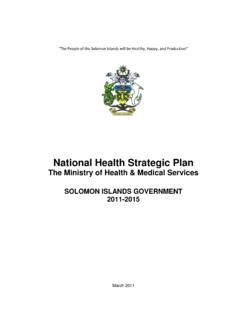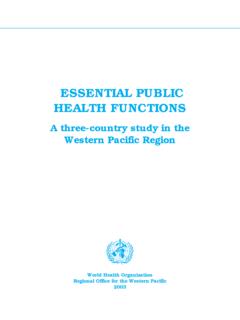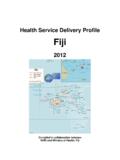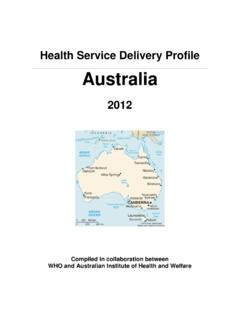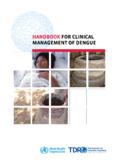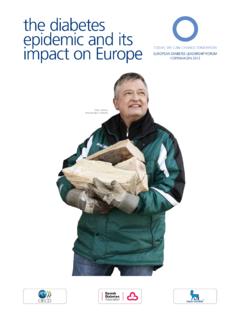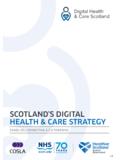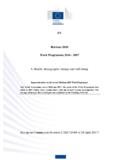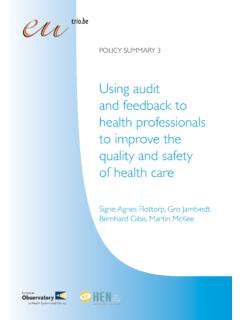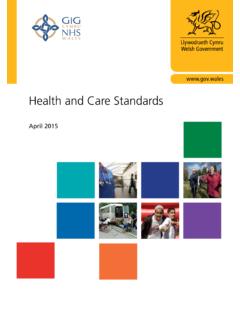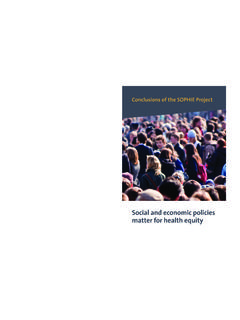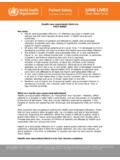Transcription of Strategic Plan for Strengthening Health Systems - …
1 1 Strategic plan forStrengthening Health Systemsin the WHOW estern Pacific RegionManila 2008 WHO Library Cataloguing in Publication DataStrategic plan for Strengthening Health Systems in the WHO Western Pacific Region . 1. Health Systems plans. 2. Strategic planning. 3. Western Pacific. ISBN 978 92 9061 384 8 (NLM Classification: WA 541) World Health Organization 2008 All rights reserved. The designations employed and the presentation of the material in this publication do not imply the expression of any opinion whatsoever on the part of the World Health Organization concerning the legal status of any country, territory, city or area or of its authorities, or concerning the delimitation of its frontiers or boundaries. Dotted lines on maps represent approximate border lines for which there may not yet be full mention of specific companies or of certain manufacturers products does not imply that they are endorsed or recommended by the World Health Organization in preference to others of a similar nature that are not mentioned.
2 Errors and omissions excepted, the names of proprietary products are distinguished by initial capital World Health Organization does not warrant that the information contained in this publication is complete and correct and shall not be liable for any damages incurred as a result of its of the World Health Organization can be obtained from Marketing and Dissemination, World Health Organization, 20 Avenue Appia, 1211 Geneva 27, Switzerland (tel: +41 22 791 2476;fax: +41 22 791 4857; e-mail: Requests for permission to reproduce WHOpublications, in part or in whole, or to translate them whether for sale or for noncommercialdistribution should be addressed to Publications, at the above address (fax: +41 22 791 4806; e-mail: For WHO Western Pacific Regional Publications, request for permissionto reproduce should be addressed to Publications Office, World Health Organization, Regional Office for the Western Pacific, Box 2932, 1000, Manila, Philippines, fax: +632 521 1036,e-mail: of ContentsAcronyms 4 Foreword 5 Executive Summary 7 1.))
3 Introduction 10 A WHO framework for Health Systems Strengthening From WHO framework for Health Systems Strengthening to action in the WHO Western Pacific Region 11 2. Key issues in Health Systems within the WHO Western Pacific Region and Regional Office Key issues affecting WHO work in Health Systems in the Region Conclusions of rapid review of WHO work in Health Systems in the Region 14 3. From framework to action Strategic direction for Division of Health Sector Development in the Region on Health Systems Strengthening A more effective role for WHO at country level Making Strategic choices on priority actions within and across the six Health Systems building blocks 20 Strengthening partnerships and the role of WHO in aid coordination 28 Improving the way we work: Strengthened collaboration, capacity and communication 30 4.
4 Conclusions 38 5. Annexes 40 Annex 1. Country priorities 41 Annex 2. Sub-regional priorities 54 Strategic plan For Strengthening Health Systems in the WHO Western Pacific Region4 AcronymsAAAH Asia Pacific Action Alliance on Human Resources for HealthAusAID Australian Agency for International DevelopmentDFID Department for International Development of the United KingdomEU European UnionEVIPNet Evidence-Informed Policy NetworksGAVI Global Alliance for Vaccines and Immunization GFATM Global Fund to Fight AIDS Tuberculosis and MalariaGHWA Global Health Workforce AllianceHIV Human Immunodeficiency VirusHMIS Health Management Information system HMN Health Metrics NetworkHSPN Health Systems Professionals NetworkHSS Health Systems StrengtheningHSSP Health Sector Strategic PlanIHP International Health PartnershipLIC Low-income CountryMDG Millennium Development GoalMTEF Medium-term Expenditure FrameworkMTR Midterm ReviewNHA National Health
5 AccountsNMP National Medicines PolicyNZAID New Zealand Agency for International DevelopmentOECD/DAC Organization for Economic Co-operation and Development/ Development Assistance CommitteeOOP Out-of-pocketPER Public Expenditure ReviewPHC Primary Health CarePHRHA Pacific Human Resources for Health Alliance (name proposed)PMO Programme Management OfficerPOLHN Pacific Open Learning Health NetworkQA/QI Quality Assurance/Quality ImprovementSO Strategic ObjectiveSPC Secretariat of the Pacific CommunitySTI Sexually Transmitted InfectionSWAp Sector-wide ApproachTAG Technical Advisory GroupTTR Treat Train and RetainWHO World Health Organization5 ForewordThe right to Health is recognized as a basic human right in the WHO Constitution since 1946 and this right was reaffirmed in the Declaration of Alma-Ata on Primary Health Care in Millennium Development Goals (MDG) are shared aspirations of the international community of nations aimed at alleviating poverty, decreasing inequality and improving social well being for the poorest in the world by the year 2015.
6 It is increasingly recognized that Health is not just a result of development and poverty reduction, but actually a precondition for development. To that end,three of the MDGs are directly Health related. Investing in Health is investing in progress has been made in the WHO Western Pacific Region with improvements in Health indicators such as life expectancy and infant mortality over the past fifty years. There has been particular success in aspects of communicable disease control, such as the control of SARS, the eradication of poliomyelitis, and making tuberculosis treatment available throughout our Region to name a few. Noncommunicable disease control has also progressed through measures such as the Framework Convention on Tobacco Control and efforts to address the epidemics of obesity and diabetes. However, as spending in the Health sector has increased it has become obvious that weak Health Systems are obstacles to achieving the desired Health outcomes.
7 The proliferation ofprogrammes and projects has led to increasing fragmentation and inefficiencies in how services are delivered. If the maximal improvements possible in Health are to be achieved, strong Health Systems are needed. WHO and Member States must place more emphasis on building and sustaining robust Health best results, Health Systems must be addressed in a holistic, comprehensive, and balanced manner. The fact that Health Systems issues are complex and difficult makes it more, not less important, that they be tackled. Everybody s Business: Strengthening Health Systems to Improve Health Outcomes is a Framework for Action that was developed to guide the WHO Secretariat in its work in Health that end, the WHO Regional Office for the Western Pacific has developed this Strategic plan for Strengthening Health Systems in the WHO Western Pacific Region to provide more specific strategies for how we will approach Health Systems in the Region using the WHO Framework.
8 The increased emphasis on Health Systems is not a threat to or a competition with other programmes within WHO. The renewed emphasis on Health Systems is a call for collaborative and complementary action within and between programmes to achieve our common goal of improved Health outcomes for all of the people of the Region. The need for such collaboration and cooperation is obvious and the emphasis on Health Systems is overdue. I am confident that this Strategic plan is a good Omi, MD, Director7 Executive SummaryWeak Health Systems have been identified as obstacles to improving Health and achieving international Health targets such as the Millennium Development Goals (MDG) and realizing the lofty principles of Primary Health Care outlined so articulately at Alma-Ata in 1978. Increased international assistance in Health has helped achieve results, but it also has contributed to increasing fragmentation of the Health sector and highlighted the need for more holistic approaches to Health Systems .
9 Everybody s Business: Strengthening Health Systems to Improve Health Outcomes is a framework for action developed by the WHO Secretariat to guide its work. A Strategic plan for Strengthening Health Systems in the WHO Western Pacific Region has been developed as a regional response to Everybody s Business in an effort to make it more operational and to guide the work of the WHO Regional Office for the Western Pacific in general and the Division of Health Sector Development s Business identifies four pillars for WHO action in Health Systems . They are: 1. a single framework with six building blocks; 2. Health Systems and Health outcomes programmes: getting results; 3. a more effective role for WHO at country level; and 4. the role of WHO in the international Health Systems single framework includes the following six building blocks which are used as a core templatefor analysis:1. financing;2. Health workforce;3. information;4.
10 Medical products and technology;5. service delivery; and6. key elements of the regional Strategic response outlined in Section 3 include: 1. a clearly defined Strategic direction for the work of the Division of Health Sector Development in the WHO Western Pacific Region;2. improved responsiveness to country and country office needs and intensified analytic work and support to national Health planning processes;3. Strategic actions across the six building blocks;4. strengthened engagement in partnerships at multiple levels; and 5. improved working methods including better collaboration, increased capacity in Health Systems and improved plan For Strengthening Health Systems in the WHO Western Pacific Region8 Country work, particularly support to national planning processes, and cross-divisional work will assume greater importance. Key cross-cutting issues that do not fall strictly under the six building blocks will also be tackled.

